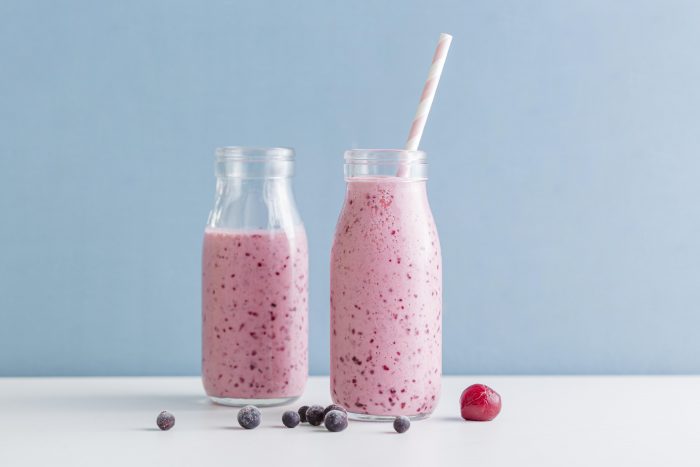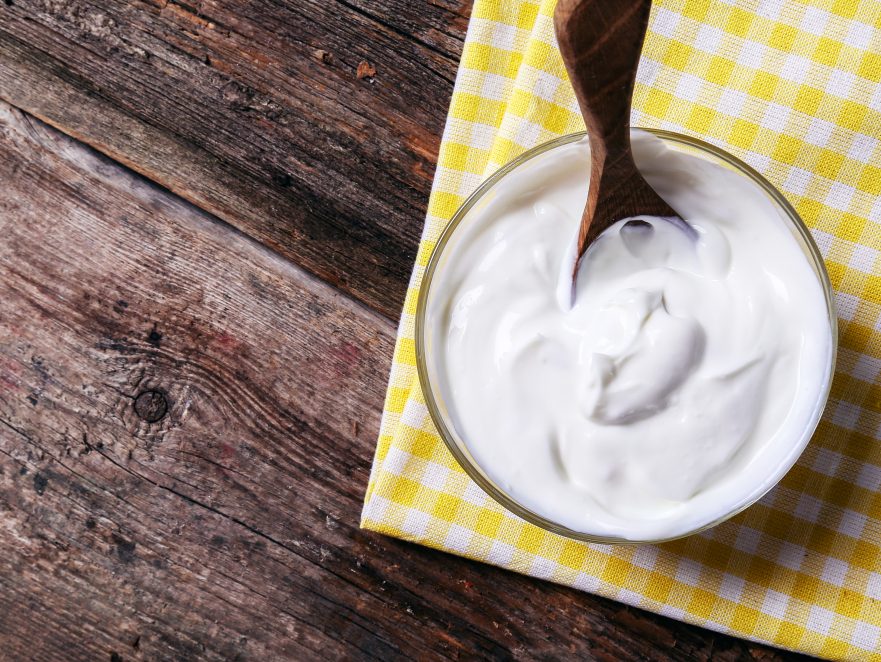What Is Yoghurt?
Yoghurt is produced by bacterial fermentation of milk. The bacteria
used to make yoghurt are beneficial bacteria and are known as
yoghurt cultures. The culture ferments lactose, the natural sugar found in milk. This produces lactic acid, which gives yoghurt its texture and characteristic tart flavour.
How to Choose a Healthy Yoghurt and Enjoy Its Benefits
Avoid commercial yoghurt with added sugar, sweeteners, fruit juice concentrates, high-fructose corn syrup and flavouring; they lose many of yoghurt’s healthy attributes.
Instead, start “clean” with plain yoghurt and add a bit of honey to taste. As long as you are eating the right type of yoghurt, you are in for tons of health benefits. Below are some of the amazing benefits from eating yoghurt regularly:
- An excellent source of protein
Yoghurt provides a high-quality source of protein and the fermentation process improves the digestibility of the milk protein—casein. Without this fermentation process, casein can be hard to digest, which may cause allergic and undesirable reactions within the body.
- Improves lactose tolerance
The culturing process also helps to partially digest lactose, making it easier to absorb and less allergenic. This seems to improve lactose tolerance in children and adults who are lactose intolerant.
- A rich source of vitamins and micronutrients
Yoghurt is a rich source of several vitamins and minerals, such as vitamin B12, calcium, phosphorus and riboflavin.
- Improves the bioavailability of nutrients
The lactic acid in the yoghurt aids in digestion and increases absorption. As a result, the amount of nutrients yoghurt provides for the body is more than that of the same volume of milk.
- Boosts immunity
The bacterial cultures in yoghurt have been shown to stimulate infection-fighting white cells in the bloodstream. Researchers also found that those who ate two cups of live-culture yoghurt daily produced higher levels of immunity boosting interferon.
- Aids healing after intestinal infections
The live bacterial cultures in yoghurt can help replenish the intestines with friendly bacteria. Therefore, yoghurt is commonly used for restoring normal bacteria in the intestine after a course of antibiotics and for treating antibiotic-associated diarrhoea and acute diarrhoea in children. Research shows that children recover faster from diarrhoea when eating yoghurt.
- Contributes to colon health
Yoghurt contains lactobacteria, a gut-friendly bacterial culture that fosters a healthy colon. Lactobacteria, especially acidophilus, promotes the growth of healthy bacteria in the colon and reduces the conversion of bile into carcinogenic bile acids. The more of these gut-friendly bacteria that are present in your colon, the lower the chance of colon diseases including colon cancer.
Secondly, as mentioned earlier, yoghurt is a rich source of calcium. Calcium discourages excess growth of the cells lining the colon, which can place a person at high risk for colon cancer. Calcium also binds cancer-producing bile acids and keeps them from irritating the colon wall. People who have diets high in calcium, for example the Scandinavians, tend to have lower rates of colorectal cancer.
- Helps decrease yeast infections
Some women use yoghurt inside the vagina for treating vaginal yeast infections and vaginal bacterial infections in pregnancy. Yoghurt is also used for preventing urinary tract infections.
- Lowers cholesterol
There are a few studies that have shown that yoghurt can reduce blood cholesterol. This may be because the live cultures in yoghurt can assimilate the cholesterol or because yoghurt binds bile acids (which has also been shown to lower cholesterol), or both.
- A valuable health food for both children and elderly persons
For children, it is a balanced source of protein, fats, carbohydrates and minerals in a texture that kids love. More importantly, yoghurt helps children grow better because the lactic acid in the yoghurt improves the digestibility of the protein and increases the absorption of nutrients.
For senior citizens, who usually have more sensitive colons or whose intestines have run out of lactase (an enzyme that breaks down lactose), yoghurt is also a valuable food. Also, aging can cause declining levels of bifidus bacteria in the guts, which can lead to the growth of toxin-producing bacteria, and perhaps even cancer-causing bacteria. The live bacterial cultures in yoghurt can help replenish the intestines with friendly bacteria.

Magical Ways to Use Yoghurt
Yoghurt is not just for breakfast! Here are some amazing ways to use plain yoghurt for food, beauty and home:
In the kitchen
- Smear it on fish: a coating of yoghurt and herbs gives baked fish a crispy, tasty crust.
- Marinate chicken: the lactic acid in yoghurt helps to tenderize the chicken. Rub chicken thighs with yoghurt and yellow curry powder or turmeric powder before grilling or baking.
- Make a creamy marinara sauce by adding a few spoons of natural plain yoghurt to a basic tomato sauce.
- Soften scrambled eggs: whip in a dollop of yoghurt before frying.
- Make a creamy, low-fat salad dressing: stir some freshly grated garlic cloves into yoghurt and whisk in flaxseed oil, lime juice and fresh herbs.
- Make frozen yoghurt pops: mix plain yoghurt with fresh or frozen fruit (banana, mango or berries are good choices), pour it into moulds and freeze.
- Make frozen yoghurt bark: line a baking sheet with wax paper and spread the yoghurt in an even layer, about ¼ to -inch thick. Top with chopped berries, chocolate and nuts. Freeze until firm. Break into shards and keep frozen until ready to serve.
- Whip up a smoothie: 1 cup of yoghurt, 1-2 teaspoons of honey, 1 tablespoon of flax seed oil, 1 tablespoon of extra virgin coconut oil, fruits and some ice cubes. Blend well until smooth.
- Prepare an overnight muesli: mix 1 cup muesli with 1 cup of yoghurt. Refrigerate overnight in a jar. Serve with honey, nut butter and fresh fruits.
- Swap in for butter when baking: try replacing half the butter with half as much yoghurt. The lactic acid in yoghurt helps to relax the gluten in flour and make dough extra moist. This can provide you with perfectly moist banana bread and fluffier waffles, pancakes or cinnamon rolls!
- Substitute for cream cheese: yoghurt cheese is creamy like regular cream cheese but gives you better protein and nutrients with a touch of tartness and fewer calories. To make yoghurt cheese, place two cups of yoghurt in a strainer lined with cheesecloth. Allow to sit overnight. In the morning, you’ll have about one cup of delicious, spreadable yoghurt cheese. Add some herbs for extra flavour.
- Healthy replacement for mayonnaise (mayo) and sour cream: yoghurt works well in stuffed eggs, potato salad, chicken salad and tuna salad. Not only does it contain fewer calories and less fat, yoghurt has a characteristic tang that contrasts well with the richness of these dishes.
Beauty Uses
- Fight acne: the antibacterial and anti-fungal properties of yoghurt can help fight acne. Apply yoghurt to the skin, allow it to sit for 30 minutes and then wash it off with lukewarm water.
- Improve skin clarity: the lactic acid in yoghurt is an alpha-hydroxyl acid. When used daily, it may result in improved skin clarity.
Try these homemade facial masks:
- Anti-aging mask: in a small bowl, mix ¼ teaspoon spirulina powder, ¼ teaspoon honey, and 1 teaspoon yoghurt. Apply and rinse off with a warm wash cloth after 10 to 15 minutes, or until dry.
- Exfoliating mask: mixing yoghurt with a little ground oatmeal or almond. Apply the mixture to the face, neck and chest. Wash off after 10 minutes, or when dry.
- Soothe psoriasis: slather yoghurt over the affected areas and leave on the skin for 30 minutes. Rinse with lukewarm water.
- Relieve sunburn: yoghurt contains zinc which soothes sunburn skin and helps relieve itchiness. Apply in a thick layer, then wash it off after 20 minutes.
Household
Polish brass: rub plain yoghurt onto tarnished brass. As the yoghurt dries, its lactic acid will dissolve the tarnish. Rinse off the dried yoghurt with water. Dry and buff to a shine using a soft cloth.
 NewLife™ Low Fat Milk Powder
NewLife™ Low Fat Milk Powder
Produced from grass-fed cows on the lush pastures of New Zealand, certified pesticide and antibiotic free, NewLife™ Low Fat Milk Powder provides an excellent ingredient for yoghurt-making, cooking, baking and much more!
Key Features:
- Pesticide-free
- Antibiotic-free
- Artificial hormone-free
- Low in fat (0.7-0.8%)
- High in calcium and other essential minerals
- Contains 40% less calories than whole milk while still providing all the
critical nutrients such as calcium, protein and Vitamin D
- Suitable for adults and children of all ages
 NewLife™ Yoghurt Starter
NewLife™ Yoghurt Starter
Easy to use, and enriched with additional probiotic strains compared to normal yoghurt starters. NewLife™ Yoghurt Starter helps you make fresh, nutritious yoghurt for your entire family!
Key Features:
- Contains live cultures: Streptococcus thermophilus and Lactobacillus bulgaricus). Fortified with three types of probiotics: Bifidobacterium longum a.k.a. “Bifidus”, Lactobacillus casei a.k.a. “Casei”, and Lactobacillus acidophilus a.k.a. “Acidophilus”
- Makes yoghurt that contains up to 100 billion live and active friendly bacteria per 100 g serving
- Easy to use and economical
- No preservatives or colouring agents
- Gluten-free
- Kosher and Halal certified


